Alaska Fish & Wildlife News
May 2025
What is the Most Invasive Species in Alaska?
Ask a Wildlife Biologist
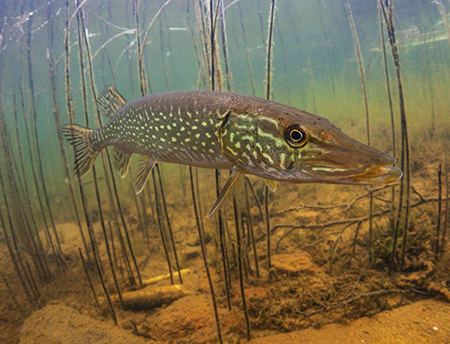
An 8th grader at Birchtree Charter School in Palmer asked, “What is the most invasive species in Alaska?”
A question like, “What is the most invasive species in Alaska?” depends on the area of interest and the type of ecosystem under consideration (primarily aquatic or terrestrial). Two crucial characteristics define an invasive species. First, these organisms are not native to the ecosystem which we are considering. But not all non-native organisms are invasive: consider the carrot - grown in many backyard gardens. The other critical feature is that invasive species cause or are likely to cause harm to environments, economies or to the health of people, plants or animals. As the invasive species program coordinator for the Alaska Department of Fish and Game, I will focus two invasive species that I think are the “most” invasive in Alaska.
The northern pike is an invasive species, but only in Southcentral Alaska. For more than 10,000 years, these hearty fish have inhabited lakes, rivers and streams in Interior and Western Alaska, as well as a small remnant population that occurs in Yakutat. In their native range they are an important resource for subsistence and sport fishing.
Although native to most of Alaska, northern pike were not found in waters of Southcentral until they were illegally introduced into Bulchitna Lake in the Yentna River drainage in the 1950s. Over time, pike have spread to nearby drainages via flooding events and to new remote locations in the region with the help of “bucket biologists” (people who illegally move fish – this is not a complimentary term). Now they are widespread.
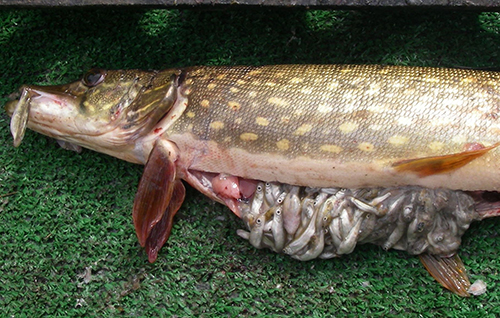
The invasiveness of northern pike is illustrated by the significant negative impacts they have caused in the region. These voracious, apex predators established large populations in Southcentral because they found suitable habitat and plentiful salmon, rainbow trout, Dolly Varden and other native fish to eat. As newcomers to these ecosystems, there were few natural predators to keep pike numbers in check. In time, northern pike became the dominant fish in many freshwater systems in the region.
The Alexander River drainage in the Susitna River basin provides a prime example of the costly negative impacts pike cause where they are invasive. These efficient predators are distributed in this system from Alexander Lake through many river miles with side channel sloughs and slow moving water where salmon once had strong productive runs. Northern pike effectively depleted the salmon in the drainage, causing the sport fisheries to close. Subsequently, the once thriving economy which was built around salmon fishing collapsed.
Despite decades of successful northern pike suppression and eradication projects by the Alaska Department of Fish and Game (ADF&G), northern pike continue to cause declines in salmon fisheries and reductions in fishing opportunity. Still, without these efforts to control invasive northern pike populations where it is feasible to do so, loss of fisheries and native populations of fish throughout Southcentral would be far worse. Every invasive northern pike project conducted is intended to restore impacted fisheries and prevent northern pike from spreading further.
Northern pike are a prime example of one of the most invasive species in Southcentral Alaska. Another invasive species fitting that description is European green crab. Some researchers from the U.S. Atlantic coast have labeled them “one of most invasive species in marine ecosystems.” This is concerning considering they are now established in Southeast Alaska.
European green crab
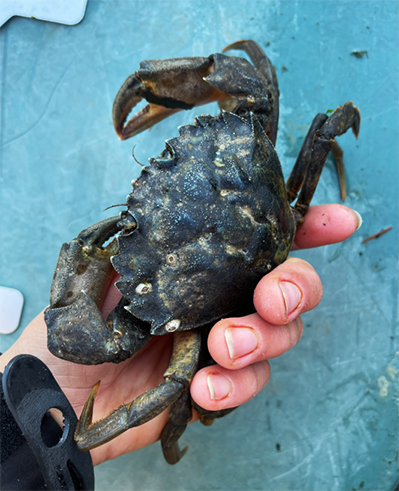
The native distribution of European green crab includes coastal waters of western Europe (Iceland and Norway) and northern Africa (Mauritania), including the Baltic Sea in the east. European green crab are common along rocky shorelines and tidal estuaries. Their presence in coastal ecosystems in their native range is comparable to the small green and purple Hemigrapsus shore crabs Alaskans see when tidepooling. The crabs scramble to and fro between rocks, driftwood, and seaweed, sometimes burrowing into the sand for safety.
Like most invasive species, humans assisted the transport of European green crab from their native range to U.S. coastlines where they are invasive. To learn more about the history of their invasion of the Atlantic and then Pacific coasts of North America, you can read this Alaska Fish and Wildlife News article.
Introduced species become dominant in an ecosystem where survivorship comes easy: food is available, the environmental conditions support their various life stages, and there are few predators or those that exist cannot compete with the invader. The additional attribute common among most invasive species is they are highly fecund. In this case, European green crab produce an astounding 200,000 eggs in one reproductive cycle, and if water temperatures are suitable, they may have several reproductive cycles in a year. In sum, suitable habitat and the ability to produce large populations aids invasive species in their new environment. European green crab have the added benefit of being incredibly adaptable to a variety of environmental conditions such as water temperature and salinity.
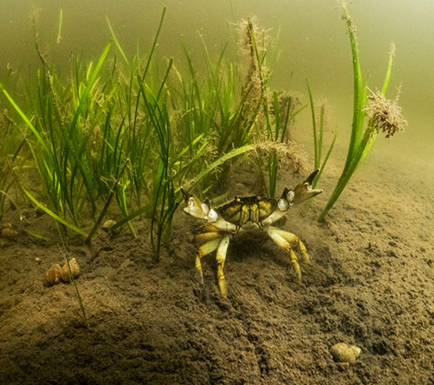
When these invasive crabs arrived on the U.S. East Coast centuries ago, their potential for destruction was unknown. Yet, the signs were becoming clear in the 1980s and 1990s, a time when a prosperous soft-shell “steamer” clam industry provided jobs and income for coastal communities. By then, European green crab had become prolific along the coast and shellfish farmers began to see drastic declines in their harvest. With a daily diet of approximately 40 clams, these aggressive, invasive crabs were causing reductions in clam productivity because they consumed both juvenile and adult shellfish. In addition to directly preying on shellfish, the invasive crabs issued a secondary assault with their foraging behavior. The clawing and digging in the sediment and uprooting and clipping seagrass disrupts the habitat where shellfish live and reproduce. The multi-million dollar shellfish economy nearly collapsed when fewer soft-shell clams, mussels and oysters could be harvested.
In the world of invasive species there is a saying, “If you can’t beat ‘em, eat ‘em.” Today, many on the U.S. East Coast are invested in utilizing European green crab as an economic resource, for food, fishmeal, compost, medical uses, or even whiskey.
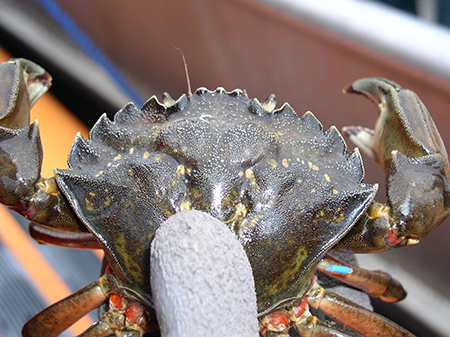
Without human intervention, a crab cannot make a cross-country journey from the Atlantic coast to the Pacific ocean. European green crab made their way to California in the late 1990s via the live food trade. When they arrived, these aggressive, insatiable, highly prolific invasive crabs found another environment suited to their successful invasion. The juvenile life stages of European green crab do not need humans to relocate, they can travel for up to 90 days on ocean currents, transiting hundreds of miles when conditions are right. This facilitated the spread of European green crab from California to all the West Coast states, as well as British Columbia, Canada. Alaska is the most recent location to be invaded by invasive green crab.
These non-native crabs pose the invasive species double whammy: 1) they consume large amounts of native shellfish resources, many with generous economic value, and 2) they cause destruction of eelgrass beds which provide refuge and nursery habitat for juvenile salmonids, herring and other fish, as well as benthic habitat for shellfish and marine invertebrates. For these reasons, I believe European green crab are one of the “most” invasive species in Alaska.
More information about invasive species in Alaska
To report observations of organisms known to be or suspected to be invasive by either calling the Alaska Invasive Species Hotline: 1-1877- INVASIV or online at the Alaska Invasive Species Reporter
Subscribe to be notified about new issues
Receive a monthly notice about new issues and articles.
